We all spend a lot of time in our cars. Most people are prepared for a low cell phone battery or chapped lips, but what about something genuinely life-threatening?
A flat tire, dead battery, or minor crash can turn into something far worse if you’re not prepared to handle it. A basic car survival kit can make all the difference, but what should yours include?
We have answers! The Pew Pew Tactical team has car nuts, outdoor enthusiasts, and peppers who have answers to all your questions.
Let’s get your car prepared for an emergency!
THE QUICK LIST
-
Best First Aid Kit
-
Best Scissor Jack Replacement
-
Best Lug Wrench Replacement
-
Best Battery Jumper
-
Best Work Gloves
-
Best Glass Breaker
-
Best Flashlight
Table of Contents
How We Tested the Best Gear for Your Car Survival Kit
For this article, we gathered a bunch of emergency survival gear we’ve personally reviewed, owned, and used here at Pew Pew Tactical. We also included some recommendations from people we know and trust. The entire Pew Pew Tactical team, as well as freelance writers, contributed to this review to offer different opinions.
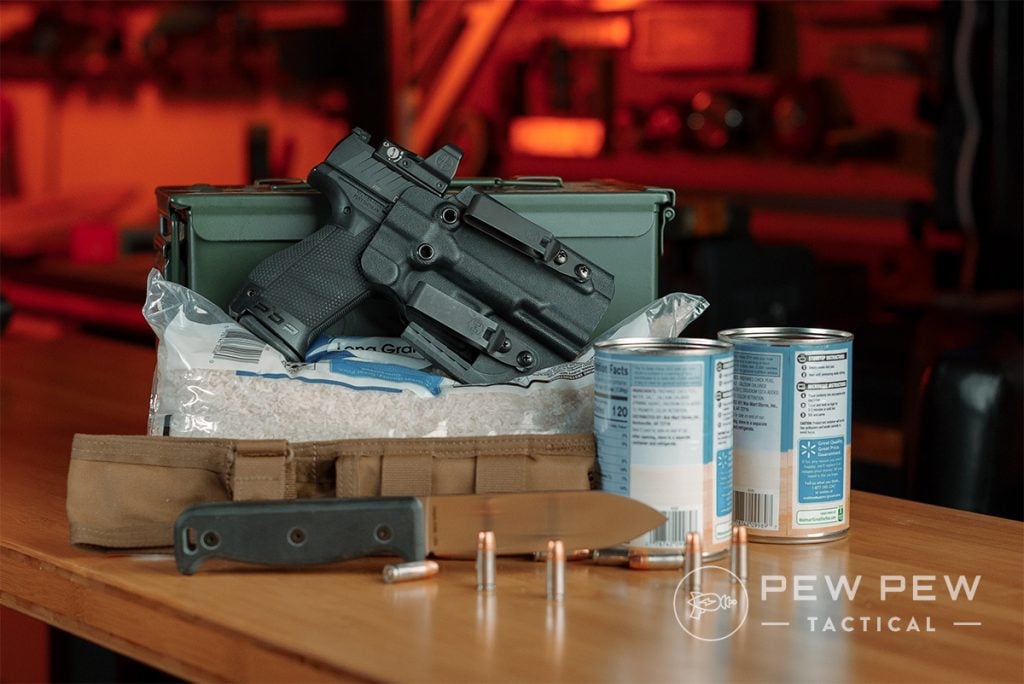
We tried to include everything from affordable everyday items to top-tier, prepper-level equipment. When possible, we also included a few alternatives to save you some money.
As always, this isn’t an exhaustive list — it’s just some of our preferred gear. If you don’t see your favorite here, drop it in the comments section so we can learn from each other!
Best Gear for Your Car Survival Kit
1. Uncharted Supply Co. First Aid Plus – Best First Aid Kit
-
25% off all OAKLEY products - OAKLEY25
Copied! Visit Merchant
Pros
- Tools included
- Treatment for mild to serious injuries
- Compact and lightweight
Cons
- Requires training
Specs
- Medical Supplies: First aid guide, nitrile gloves, CPR kit, antibiotic cream, antiseptic toilette, hypoallergenic medical tape, antibacterial wipes, bandages, gauze sponges, burn cream, splinter probes, saline tube, blister pads, pressure wrap
- Survival Supplies: Mylar blanket, stormproof matches, chem lights, zip-ties
- Tools: Tweezers, safety pins, multitool, shears, flashlight, duct tape
- Dimensions: 6.6″ x 8″ x 3.8″
- Weight: 3 lbs
I’ver shopped around for a bunch of first aid kits, and the Uncharted Supply Co. First Aid Plus is the winner. This kit rides shotgun in my car and goes with me every time I hike or snowshoe into the mountains.
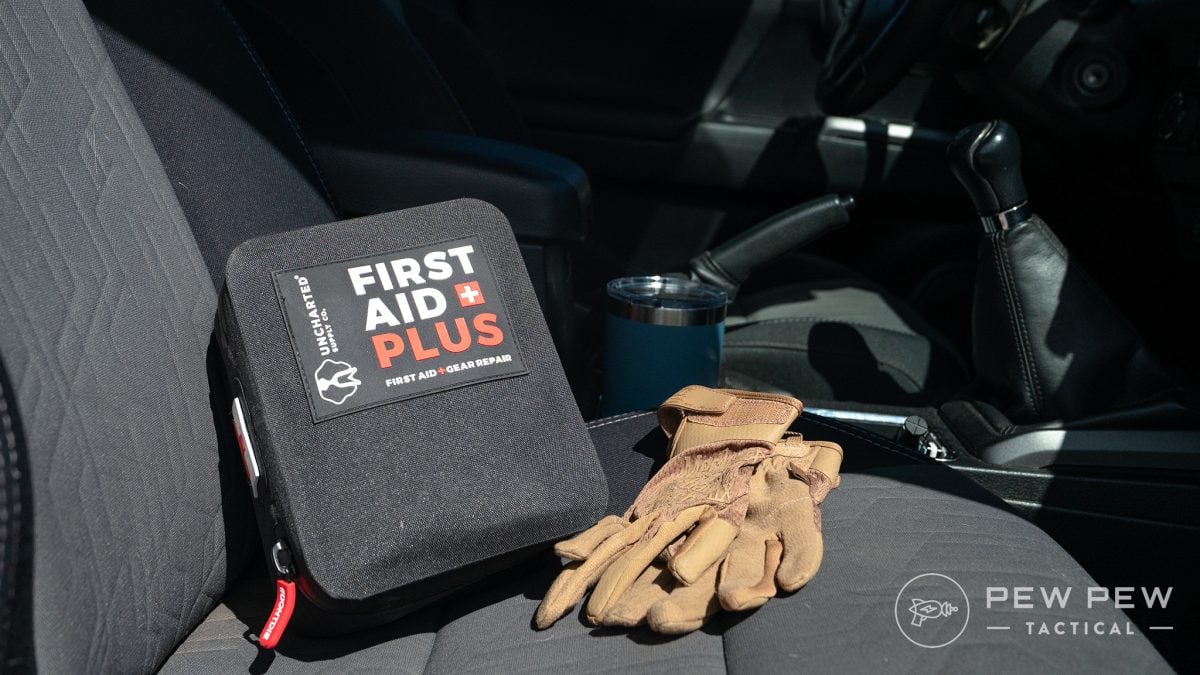
It includes all the medical supplies I’m likely to need and qualified to use. If I get a cut or scrape, it has antiseptic cream and small bandages. If I come across something more serious, there’s burn cream, a pressure bandage, and a CPR kit — along with lots of other first aid essentials.
In many cases, we can prevent injuries from happening in the first place. This kit comes with a multitool, duct tape, and zip ties so you can fix broken gear before it causes an accident.
There are some basic survival items, too, like a mylar space blanket, stormproof matches, and chem lights.
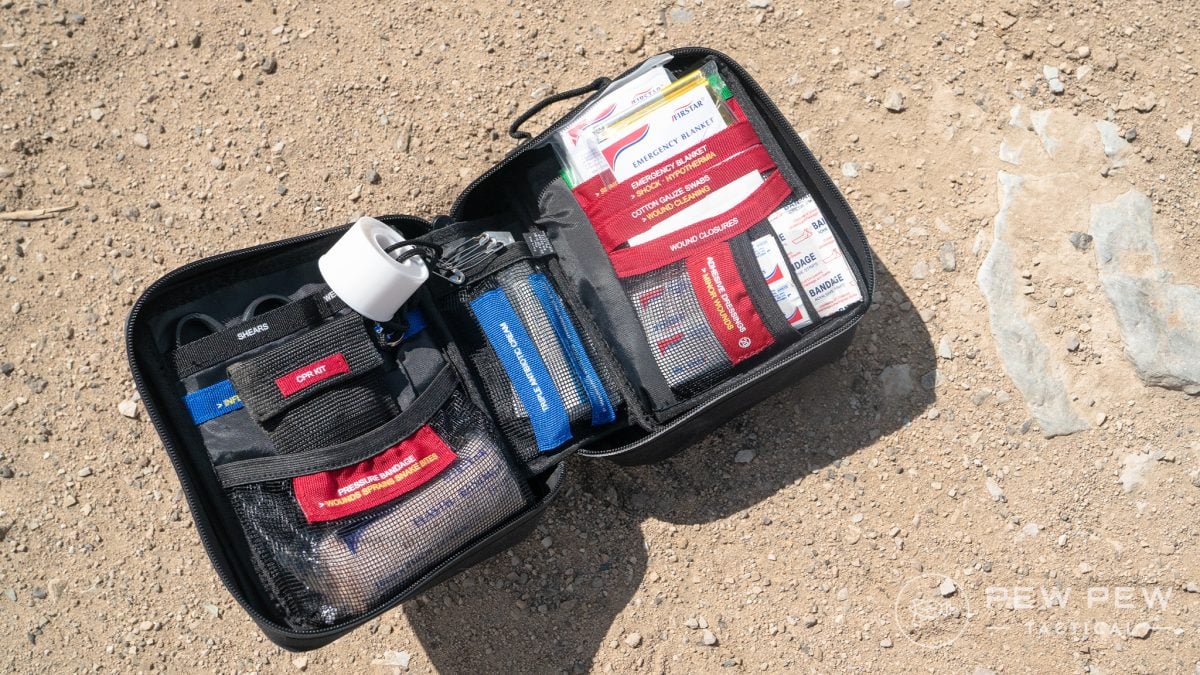
The whole thing is small enough to toss in the center console or under a seat, it has a tear-away MOLLE panel on the back, and the kit it waterproof and airtight. It’s not cheap, but you gain a ton of life-saving capability for the money.
Not all first aid kits include a tourniquet. Even if yours does, it’s never bad to have a backup. If you’re driving, it wouldn’t be unheard of to come across a serious crash that warrants putting a tourniquet on someone.
Prices accurate at time of writing
Prices accurate at time of writing
-
25% off all OAKLEY products - OAKLEY25
Copied! Visit Merchant
User error is a real risk, here, so get some training so you know how to properly use a tourniquet. Have a marker or some other way to mark the injured person with the time the tourniquet was applied so first responders know how long it’s been on there when they arrive.
No gear is a substitute for actual training, so check out our list of the Best First Aid Classes.
2. Powerbuilt 6,000-Pound Unijack – Best Scissor Jack Replacement
-
25% off all OAKLEY products - OAKLEY25
Copied! Visit Merchant
Pros
- Stable
- 6,000-pound capacity
- Integrated jack stand
Cons
- Bulky
Specs
- Weight Limit: 6,000 lbs
- Minimum Height: 11″
- Maximum Height: 21″
I’ve changed enough tires in my life to know that the jack that came in your car is probably pretty miserable to use. I’d much rather use a bottle jack and a set of jack stands, and the Powerbuilt 3-Ton UniJack is both.
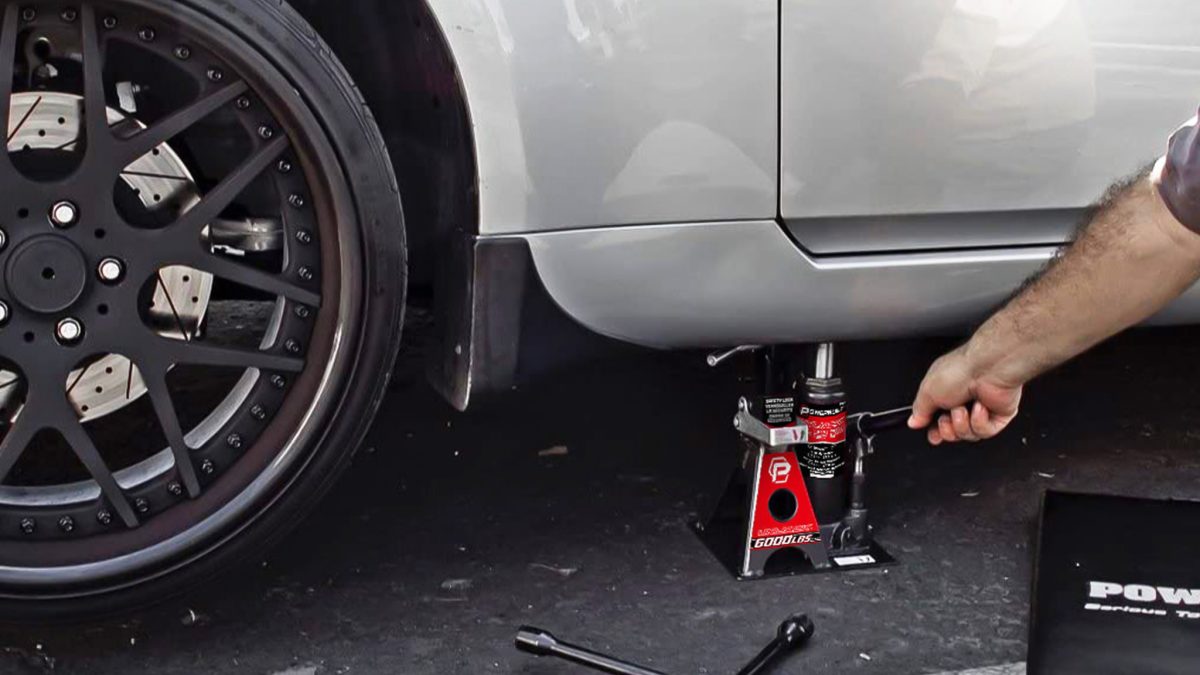
While I haven’t used this jack myself, I’ve used bottle jacks and jack stands. Put them together in one tool, and this is what you get.
Bottle jacks are more stable and probably a lot stronger than whatever your vehicle came with. This one has a 6,000-pound load rating, which should be more than enough for passenger vehicles. You’ll be grateful for that expanded footprint if you have to lift your car on an unpaved surface.
Jacks are great for lifting cars, but I don’t trust them enough to crawl under several thousand pounds of metal. That’s why it has an integrated jack stand that relies on solid metal — not hydraulic pressure and rubber seals — to hold the weight of your car.
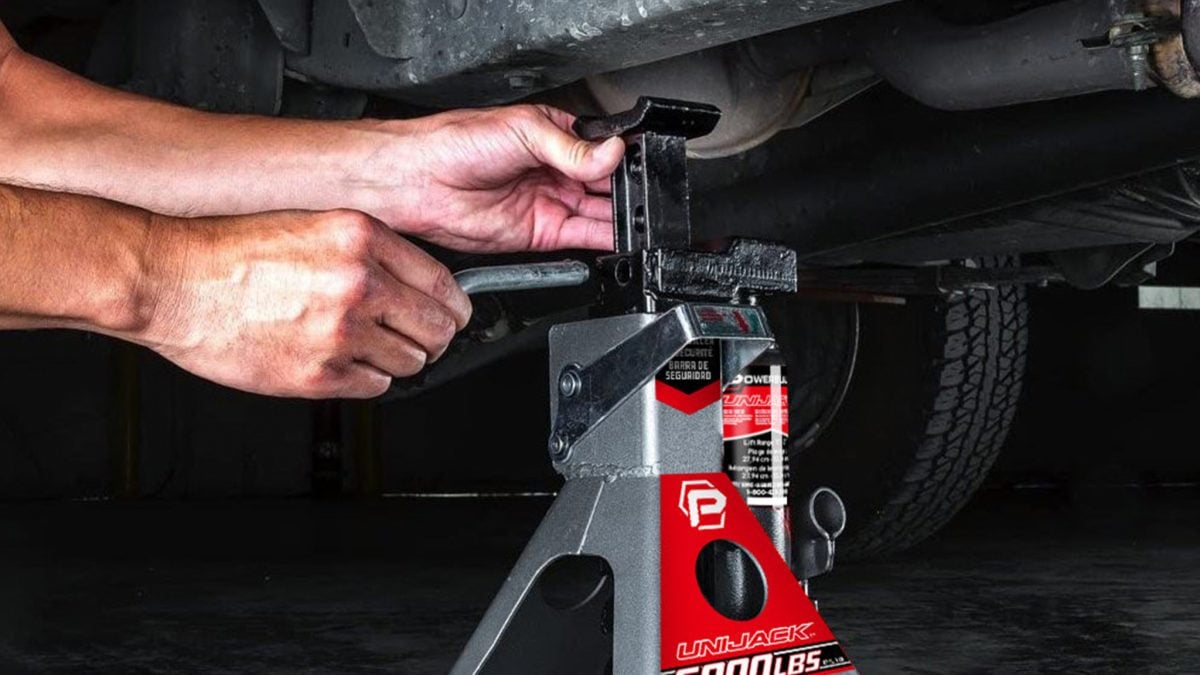
By combining the two, Powerbuilt created a much safer way to change a tire. The design also takes up less space than a separate jack and jack stand, which could be a difference maker.
This 11-inch setup might be too tall to fit under certain cars, but I have to think it’ll work with all trucks and SUVs.
3. Craftsman Breaker Bar – Best Lug Wrench Replacement
-
25% off all OAKLEY products - OAKLEY25
Copied! Visit Merchant
Pros
- Improved leverage
- Compatible with any lug nut or wheel bolt
- Good build quality
Cons
- Takes up more space than your factory lug wrench
Specs
- Drive: 1/2-inch
- Length: 18″
- Material: Chrome vanadium steel
I’m sure that your car came with a lug wrench from the factory; I’m also sure that’s it’s nearly useless. Do yourself a favor and pick up a Craftsman Breaker Bar before you need to change a tire.
Between the air tools your mechanic used to mount your wheels and the natural corrosion that bombard’s the underside of your car, lug nuts and wheel bolts can be awfully stubborn when it’s time to take them off. The tiny lug wrench from your car’s roadside repair kit probably doesn’t provide enough leverage to break them loose.
This 18-inch breaker bar offers way more power. The 1/2-inch drive is also compatible with every shape and size of socket you can imagine, so it’ll work with any style of lug nut or wheel bolt. Just pick up the right socket online or at your local auto part store.
4. Clore Automotive Jump-N-Carry 325 – Best Battery Jumper
-
25% off all OAKLEY products - OAKLEY25
Copied! Visit Merchant
Pros
- Capable of jumping most passenger vehicles
- Doesn't require another vehicle
- Easy to charge and use
Cons
- More expensive than jumper cables
Specs
- Peak Output: 2,000 amps
- Maximum Engine Displacement: 8.0L gas, 3.0L diesel
- Charging: USB-C
- Power Ports: Two USB, one 12-volt
- Dimensions: 11″ x 4″ x 5″
We all fall victim to a dead car battery now and then. When it happens to you (and it will) I recommend the Clore Automotive JNC325.
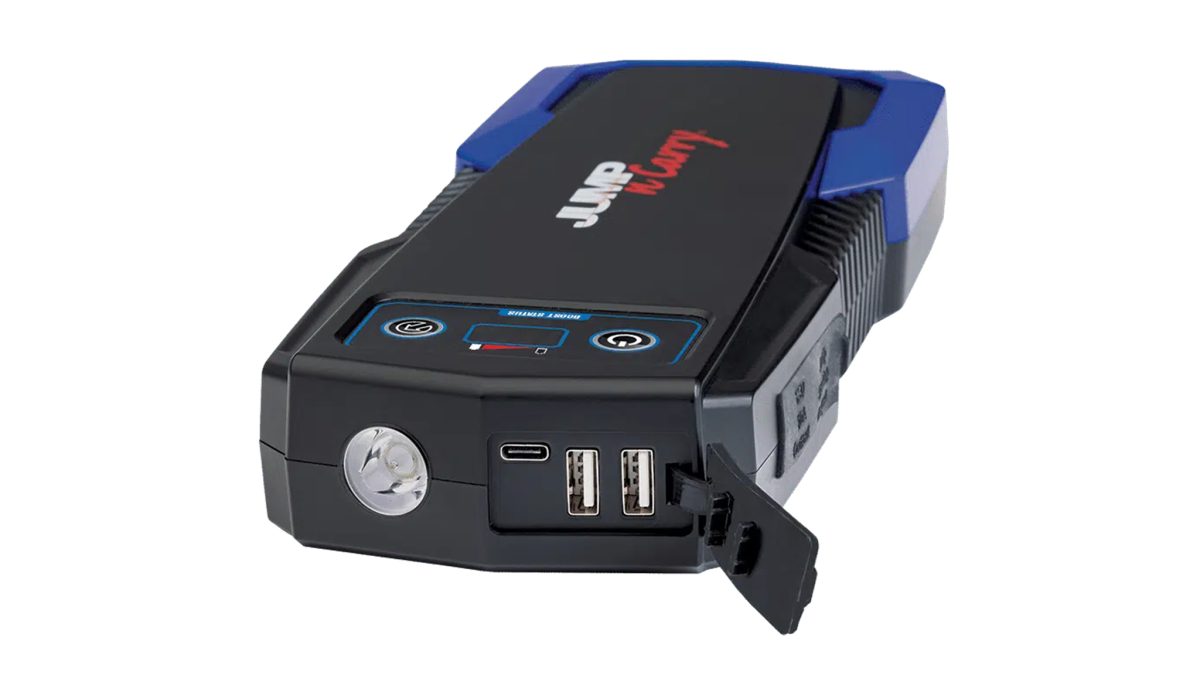
This is another piece of gear I don’t personally own, but it’s very similar to the Jump-N-Carry battery jumper someone used when they came to pick up a project vehicle that I let sit for more than a year. That old truck fired right up so fast I almost questioned my decision to get rid of it.
The 2,000-amp JNC325 takes up very little space and has enough power to jumpstart gas engines up to 8.0L in displacement and diesel engines up to 3.0L in displacement. Clore Automotive has larger battery jumpers for vehicles that draw more power.
I like battery jumpers more than jumper cables because you don’t need another vehicle to bring yours back to life. Just pop the hood, place the alligator clips on your battery or jump terminals (check your owner’s manual), power up the JNC325, and start the engine.
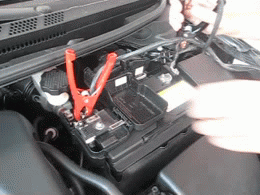
It also has two USB ports to charge other devices and a flashlight so you can see what you’re doing under the hood. The 24-inch cables will give you plenty of room to work.
This costs more than jumper cables, but I’d rather spend some money now than wait for someone to rescue me at the worst possible time.
5. Mechanix Gloves – Best Work Gloves
-
25% off all OAKLEY products - OAKLEY25
Copied! Visit Merchant
Pros
- Protect hands against cuts and burns
- Maintain dexterity
- Well-made and long-lasting
Cons
- Not warm or waterproof
Specs
- Sizes: S, M, L, XL, 2XL
- Colors: Black, coyote, gray, woodland, Multicam
- Materials: Synthetic mesh, synthetic leather
- Touchscreen Compatibile: Yes
When it comes to automotive emergencies, everything you need to touch is hot, sharp, or both. Protect your hands with a pair of Mechanix gloves.
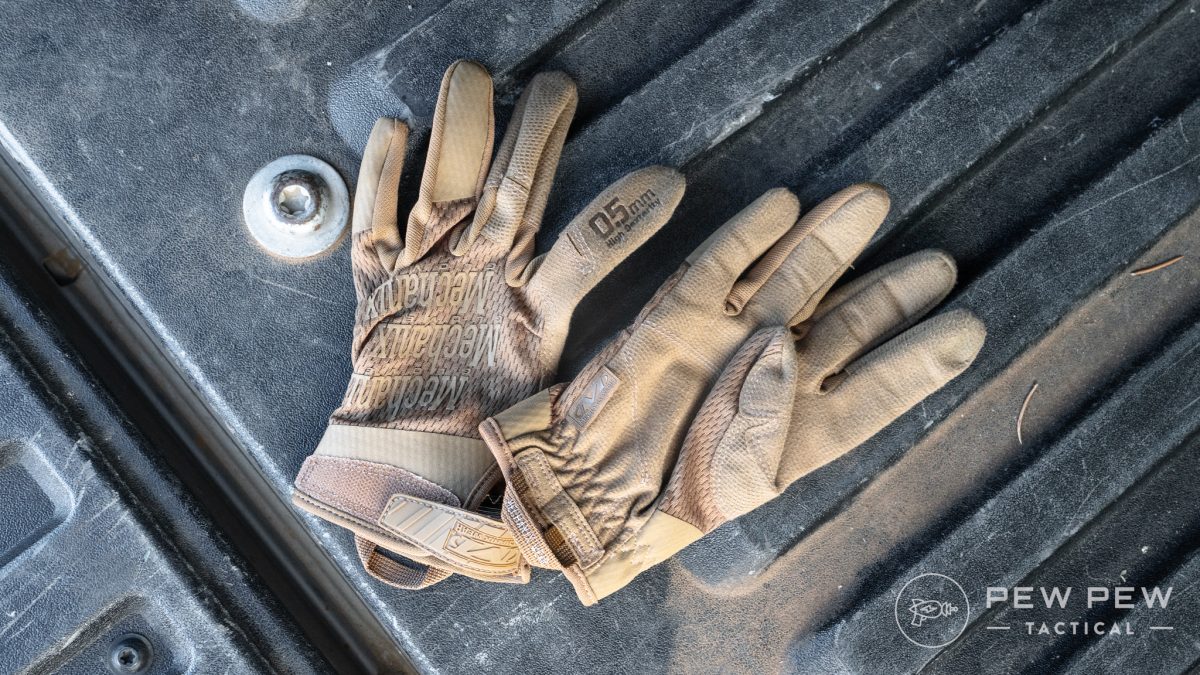
The last thing you want is wounded hands in a survival situation. Mechanix gloves are well-made with an awesome reputation for a reason. There’s a reason you can find them in just about every mechanic’s garage, military unit, and police car in the country.
Even if you don’t have to deal with broken glass or red-hot metal, these will keep you hands free of brake dust and road grime when you change a tire.
We like to shoot with them, too, so they’ll be handy the next time you go to the range.
6. 5.11 Tactical Vlad Rescue Pen – Best Glass Breaker
Prices accurate at time of writing
Prices accurate at time of writing
-
25% off all OAKLEY products - OAKLEY25
Copied! Visit Merchant
Pros
- Everyday utility
- Secure, screw-on cap
- Great leverage
Cons
- Slow to switch cap from end to end
Specs
- Glass Breaker: Carbide tip
- Material: Aluminum
- Ink cartridges: Fisher PR, Rite in the Rain 37R/47R/57R, Schmidt EasyFlow 9000
- Length: 5.6″
It’s unlikely that you’ll have to break a window to escape a crashed car or rescue someone else, but not impossible. That’s why I travel with a 5.11 Tactical Vlad Rescue Pen.
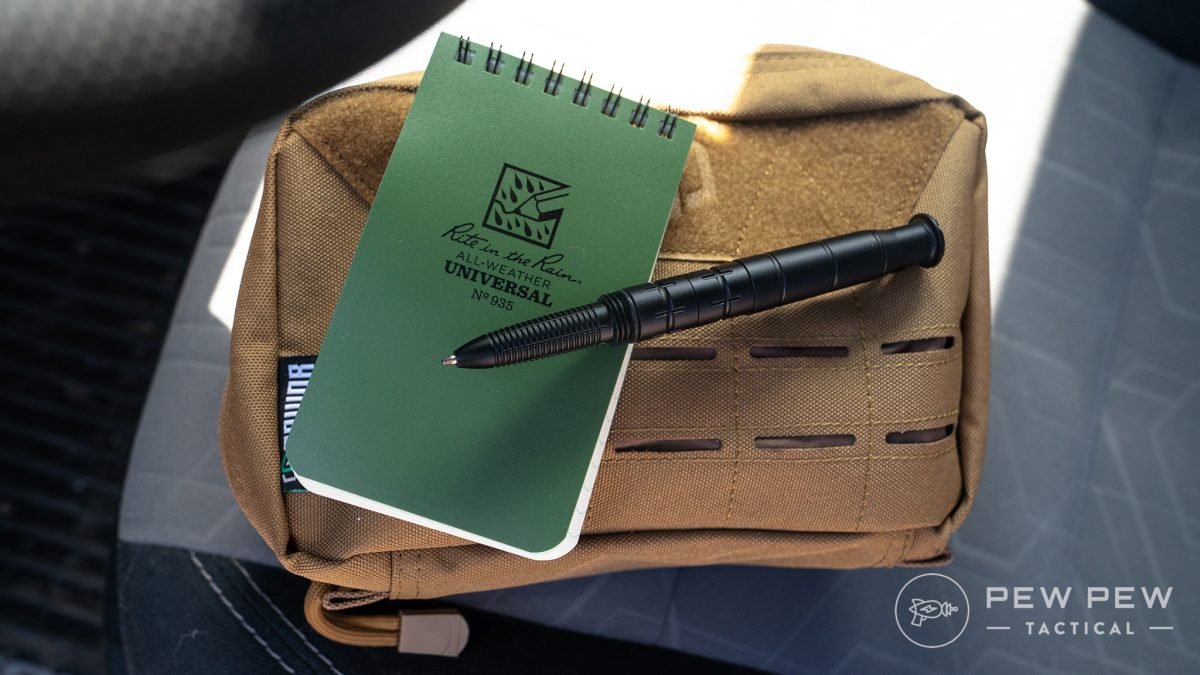
The carbide tip is sharp enough to shatter auto glass, which is notoriously tough to break — especially if you’re trapped inside with limited mobility. The aluminum body is strong and offers plenty of grip.
The rest of the time, you’ll have a useful pen instead of a dedicated glass-breaker taking up space in your car. The ink cartridge that comes with the Vlad works well on regular paper and Rite in the Rain. When it runs out, you can replace it with a cartridge from Fisher, Rite in the Rain, or Schmidt.
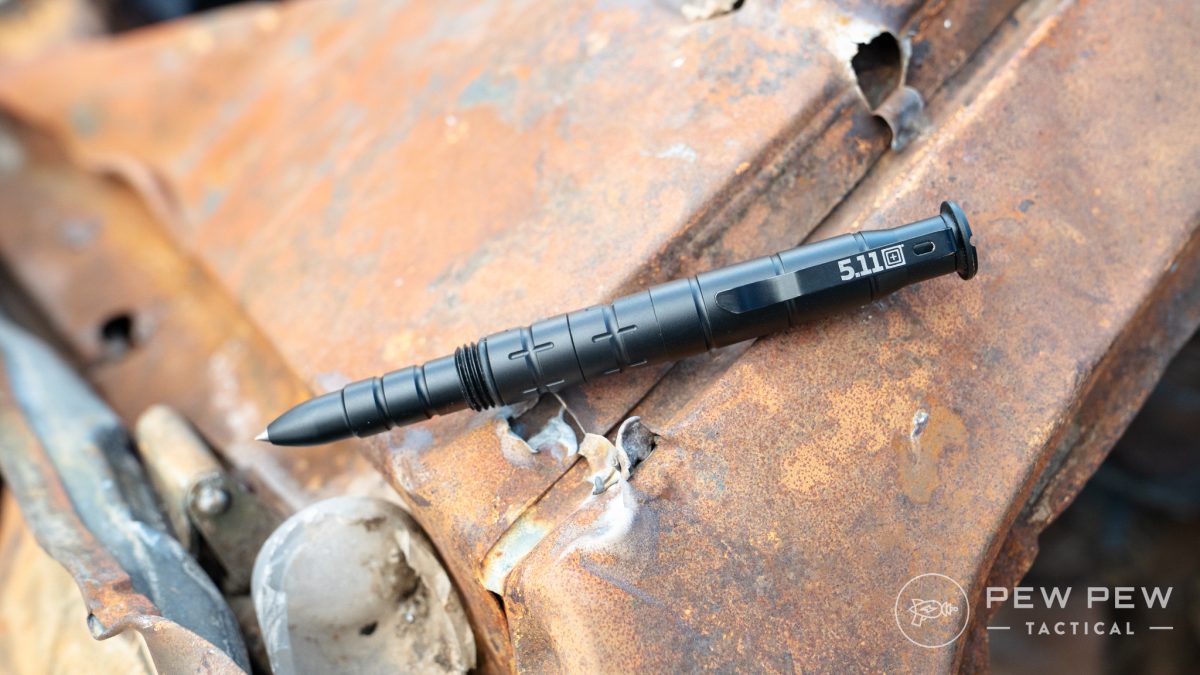
Due to the design of this pen, one end has to be exposed. Since the cap takes a few seconds to unscrew, I leave it on the end with the ink to protect the cartridge and give me quick access to the carbide tip.
When it comes to the gear I keep in my car year-round, I like things to do multiple jobs. This rescue pen is great for writing, rescue, and potentially even self defense. That’s $44 well spent in my book.
7. Surefire EDC2-DFT Turbo – Best Flashlight
Prices accurate at time of writing
Prices accurate at time of writing
-
25% off all OAKLEY products - OAKLEY25
Copied! Visit Merchant
Pros
- Extremely durable
- Multiple battery and charging options
- Not a bad improvised self-defense club
Cons
- Expensive
Specs
- Output: 700 lumens (high), 25 lumens (low)
- Maximum Range: 632 meters
- Battery: Surefire 18650 or two AA
- Battery Run Time: 1.75-2.75 hrs (high),
- Length: 5.9″
- Weight: 5.6 oz
If I were truly stranded in the dark, possibly with medical emergencies on my hands, I’d want to have a Surefire EDC2-DFT Turbo in my center console — so I do.
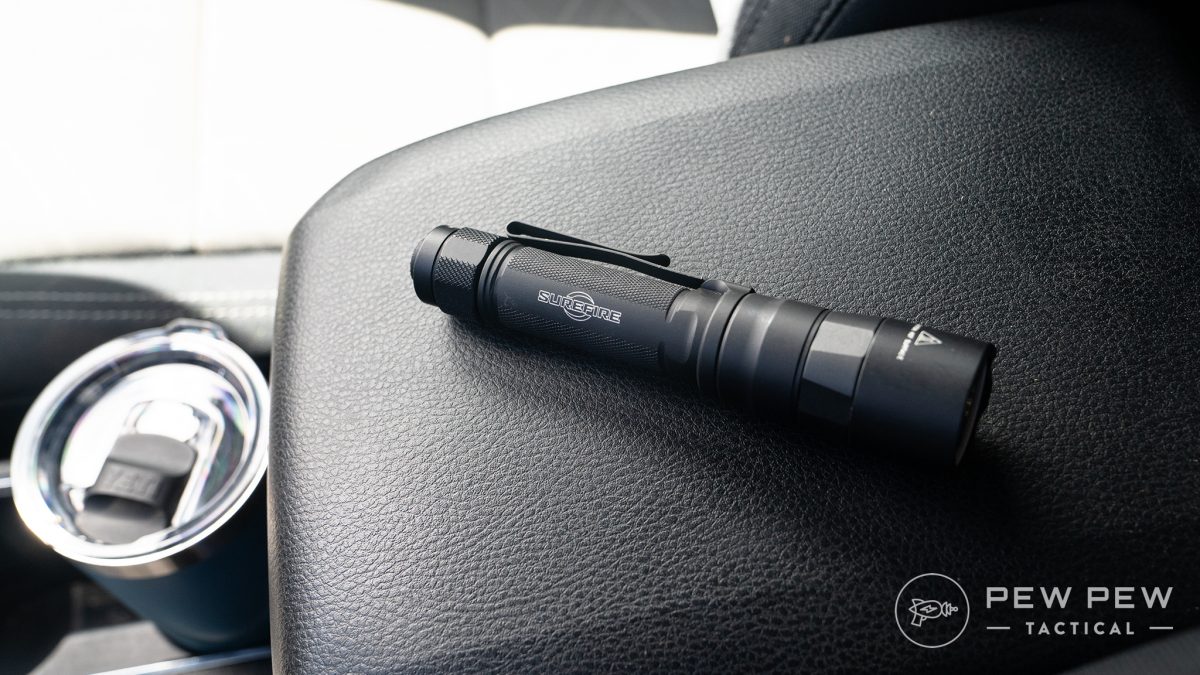
This beast of a flashlight has everything you need, and nothing you don’t. The thick aluminum exterior feels unbreakable, it’s IPX7 waterproof, and there’s only one button to manage. There’s even a two-sided clip so you can mount it to a hat brim and use it hands-free.
For the best performance, run this light off one Surefire 18650 battery that’s rechargeable via micro USB. The battery is removable, so you can hot-swap in you’re concerned about charging downtime. It can also use two AA batteries, though that’ll cost you a little bit of power.
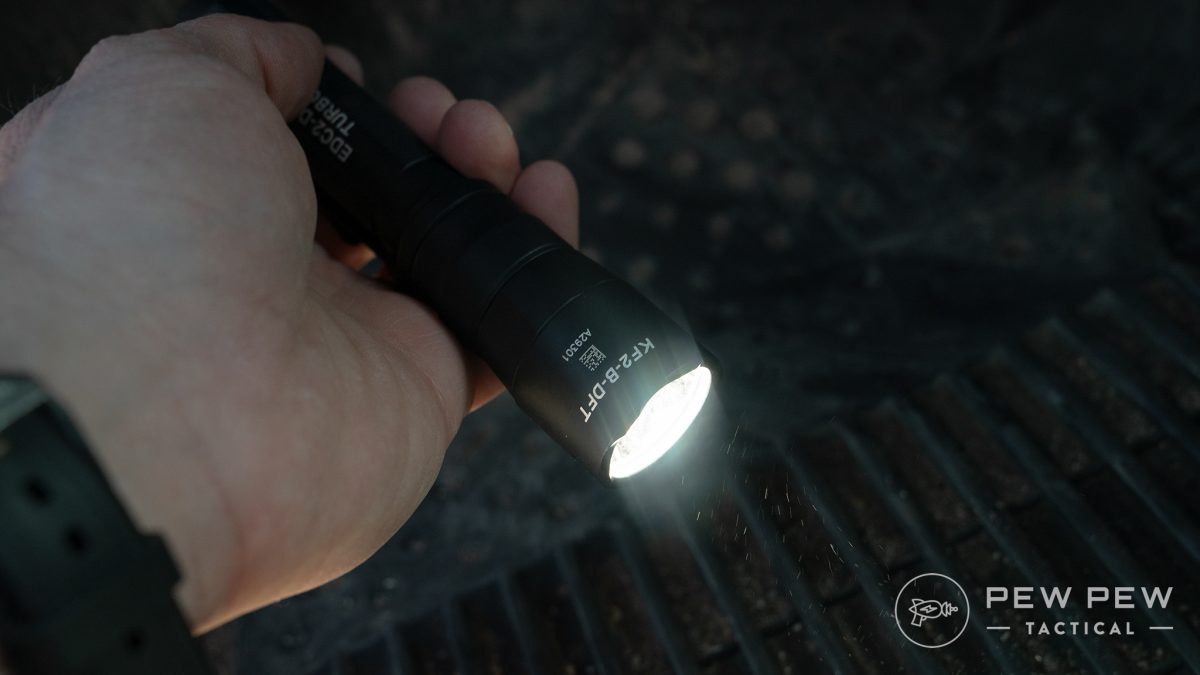
The EDC2-DFTT Turbo has two modes: a 700-lumen high mode and a 25-lumen low mode. On high, you’ll get 100,000 candela that can pierce 632 meters into the night. Low mode is great for reading or close-up tasks.
Sure, there are lights with more modes and functions, but in an emergency I just want something simple, effective, and rock-solid reliable. Unsurprisingly, Surefire checks all those boxes with the EDC2-DFT Turbo.
Don’t want to leave a high-end flashlight in your car? I don’t blame you. We also love the Fenix PD36R and it costs half as much!
-
25% off all OAKLEY products - OAKLEY25
Copied! Visit Merchant
8. Anker 325 Power Bank – Best Power Bank
-
25% off all OAKLEY products - OAKLEY25
Copied! Visit Merchant
Pros
- Small and convenient
- Affordable
- Multiple charging ports
Cons
- Limited power
Specs
- Power Capacity: 20,000 mAh
- Input Ports: USB-C, micro USB
- Output Ports: Two USB
The odds of your car going out of commission when your cell phone is at 100% charge aren’t great. I trust an Anker 325 Power Bank to keep my electronics topped off.
The last thing you want in an emergency situation is a dead phone battery. You could be buried in snow, lost in the woods, or just broken down without the means to charge your phone.

This power bank has dual charging ports so you can charge two devices at once. The battery has enough juice to charge an iPhone XS more than five times. You can charge it back up via USB-C or micro USB.
Better yet, it’s smart enough to know what it’s connected to. If you plug in your phone, it will use proprietary PowerIQ and VoltageBoost to optimize charging. If you connect it to your earbuds, it will use trickle charge to protect the tiny battery in the case.
There’s also an LED indicator so you always know how much power you have left. For less than $30 right now, you can’t beat it.
9. Sea to Summit Tanami – Best Blanket
-
25% off all OAKLEY products - OAKLEY25
Copied! Visit Merchant
Pros
- Warm
- Water-resistant
- Durable
Cons
- Bulky
Specs
- Temperature Rating: 45 degrees Fahrenheit
- Fill: 650+ duck down
- Material: 30D nylon
- Dimensions: 53″ x 73″, 83″ x 73″
- Weight: 1.3 lbs, 2 lbs
If you live anywhere that gets cold, you’re only a check engine light away from hypothermia. Carrying a blanket is a good idea; carrying a Sea to Summit Tanami is a better one.
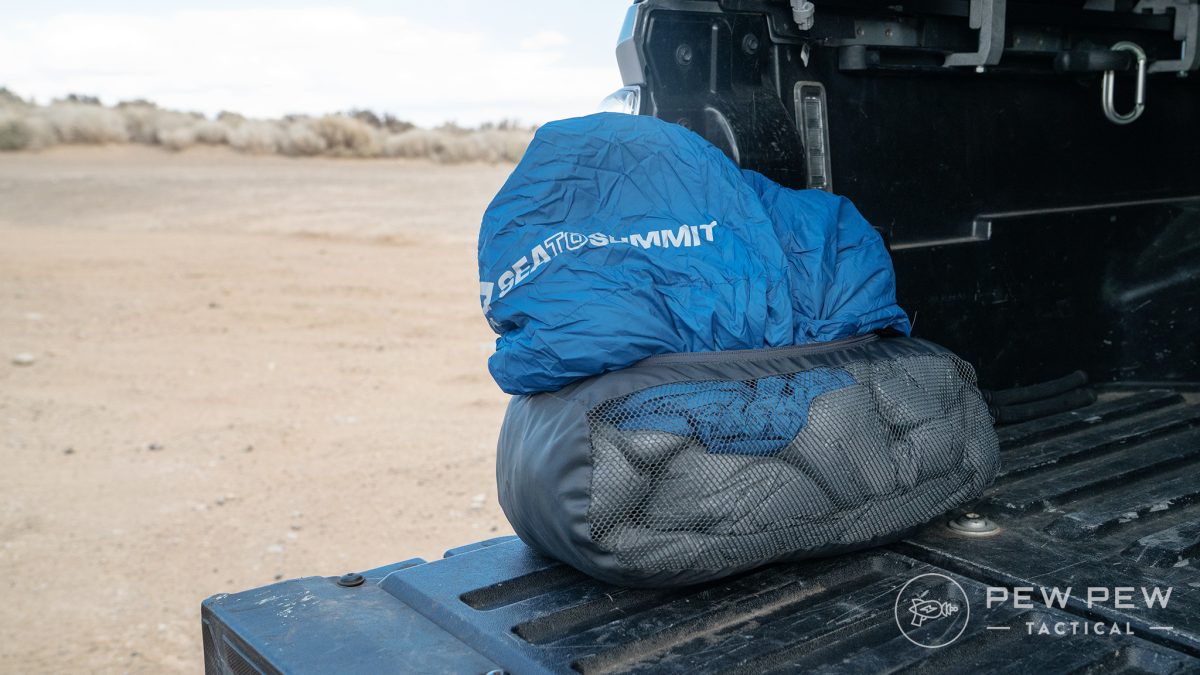
I got this blanket for car camping and backyard bonfires, but now it has a permanent place behind my seat for winter emergencies.
The 650+ duck down fill is warm and treated to repel moisture, as is the 30-denier nylon shell. I can also vouch for its ability to shrug off muddy paw prints. My Tanami is a few years old and it still looks brand new.
It is fairly bulky (this is no mylar blanket) but the queen-size camping comforter is warm, cozy, and big enough for at least two people.

You should always dress for the weather, but having this on standby makes me feel a lot better about hitting the snow-covered roads every winter.
10. MORRFlate FiveSix PSI Pro – Best Portable Air Compressor
-
25% off all OAKLEY products - OAKLEY25
Copied! Visit Merchant
Pros
- Set desired pressure digitally
- Fast and reliable
- Easy to use
Cons
- Heavy and expensive
Specs
- Power Source: Car battery
- Airflow: 5.6 cfm
- Max Pressure: 150 psi
- Noise Level: 75 dB
- Dimensions: 13″ x 9″ x 6″
I saved this one for last because it’s expensive and most people don’t need it, but you don’t have to patch a flat tire to take advantage of an air compressor. The MORRFlate FiveSix PSI Pro and a Quad+ system or single hose can also help you get through tricky terrain by optimizing the air pressure in your tires.
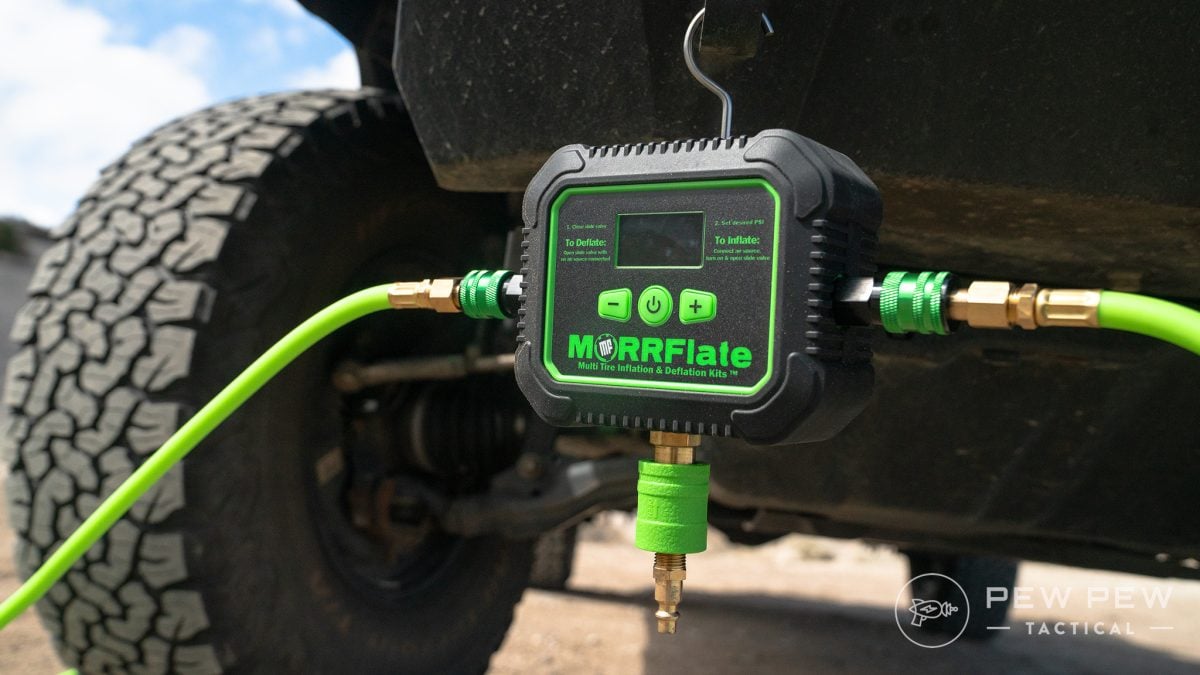
If you drive off-road, letting air pressure out of your tires (“airing down” in cool kid lingo) can help spread out the weight of your vehicle, increasing floatation and adding grip. If you have to tackle a rocky trail, it will also soften up the ride and reduce wear on your suspension.
Airing down is easy and doesn’t;t require tools; all you have to do is push on the valve stem and let it hiss out. Adding air back in when you’re done is the tricky part, and you’ll need to do that to drive on pavement safely.
The MORRFlate FiveSix PSI Pro lets you set the desired air pressure digitally and automatically shuts off when that’s reached. It runs off your car’s battery with the provided cables (keep your engine running so you don’t drain the battery). It’s a rugged off-road tool, so it can handle whatever adventures or misadventures come your way.
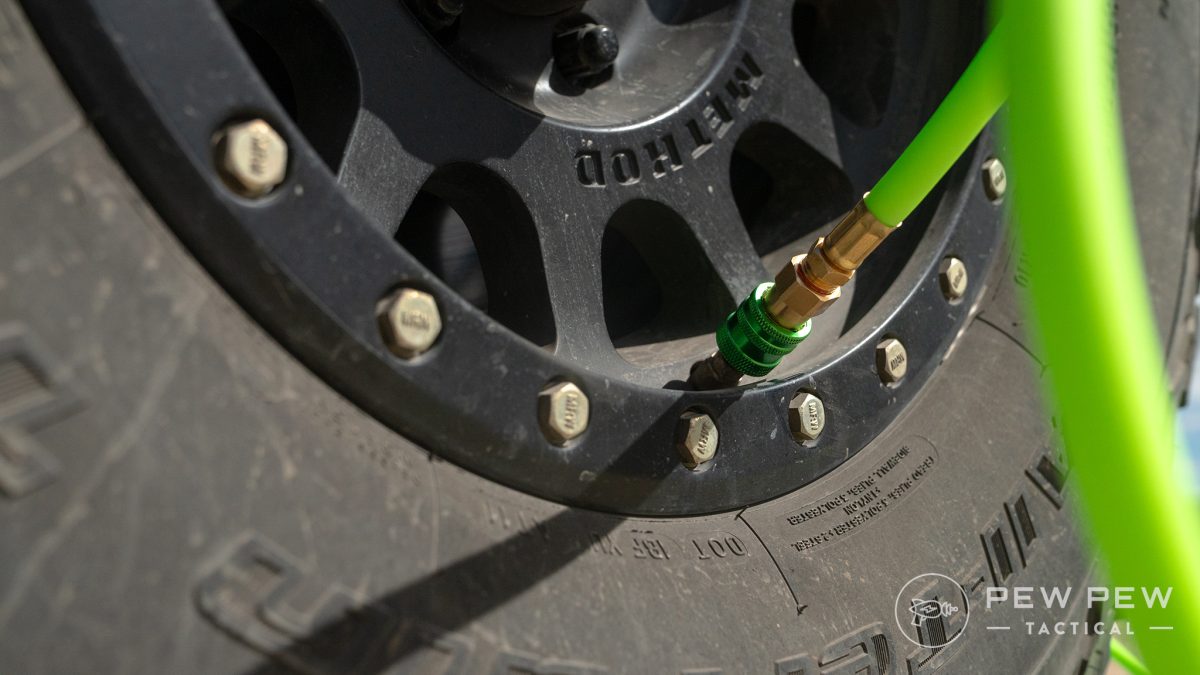
I bought the larger MORRFlate TenSix, Air Hub, and Quad+ kit to deflate and inflate all four tires at the same time, but that’s overkill for most situations. The FiveSix has all the power you need; it just takes a little bit longer.
This kit is fun for off-roading, but there’s also a real possibility I could need it in an emergency. Jammed up roads, wildfires, and extreme weather are real threats. Being able to hop off the pavement and blast across open terrain is a nice advantage to have.
How to Pick the Best Gear for Your Car Survival Kit
Some hazards, like flat tires and dead batteries, are universal. Others are more specific (am I the only one with an avalanche shovel in the back seat?).
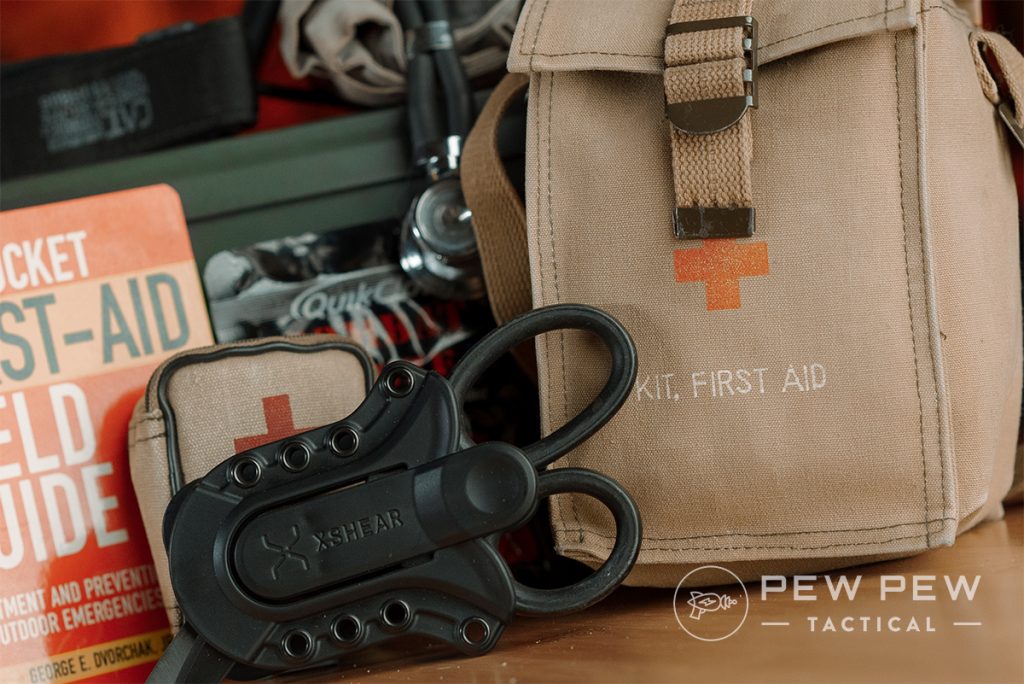
Aside from the main items we listed, here are a few other pieces of gear we like to keep handy when we’re on the go.
- Snacks: Everything is worse when you’re hungry. It can be a good idea to have a some sealed snacks with a long shelf life in your car, but avoid leaving food in your car in bear country.
- Medications: If you or someone in your family needs particular medications, it might be a good idea to keep a dose in the car. First aid kits don’t include things like epipens.
- Toilet Paper: Hey, when you need it, you need it. Throw in a small shovel for good measure.
- Duct Tape: From improvising bandages to repairing a broken window, having a roll of duct tape is super handy.
- Maps: Phones die. GPS loses signal. A road atlas of your area is forever.
- Ice Scraper: If you deal with ice and snow, having one of these is essential. Don’t be the person chipping off pieces of their credit card on a frozen windshield.
- Recovery Equipment: Sometimes calling a tow truck is necessary, but I’ve gotten myself and other drivers out of a jam plenty of times with basic recovery equipment. A shovel, traction boards, a winch can get you unstuck when nobody’s there to help. Another vehicle can often pull you out of trouble with static straps or kinetic ropes (and a basic understanding of how to use each one properly).
Once you have everything you need, pack it in a duffel bag so you it’s organized when you need it.
Prices accurate at time of writing
Prices accurate at time of writing
-
25% off all OAKLEY products - OAKLEY25
Copied! Visit Merchant
Why Trust Pew Pew Tactical
This is an update of an article originally written by Pew Pew Tactical contributor Travis Pike. Travis spent a lifetime shooting as a kid and later joined the United States Marine Corps, where he spent five years as an infantryman. In the middle of his Marine Corps career, he began writing and never stopped. Travis is an NRA-certified instructor and Concealed Carry Instructor for the state of Florida. He has thousands of articles to his name with a variety of publications, including Pew Pew Tactical.
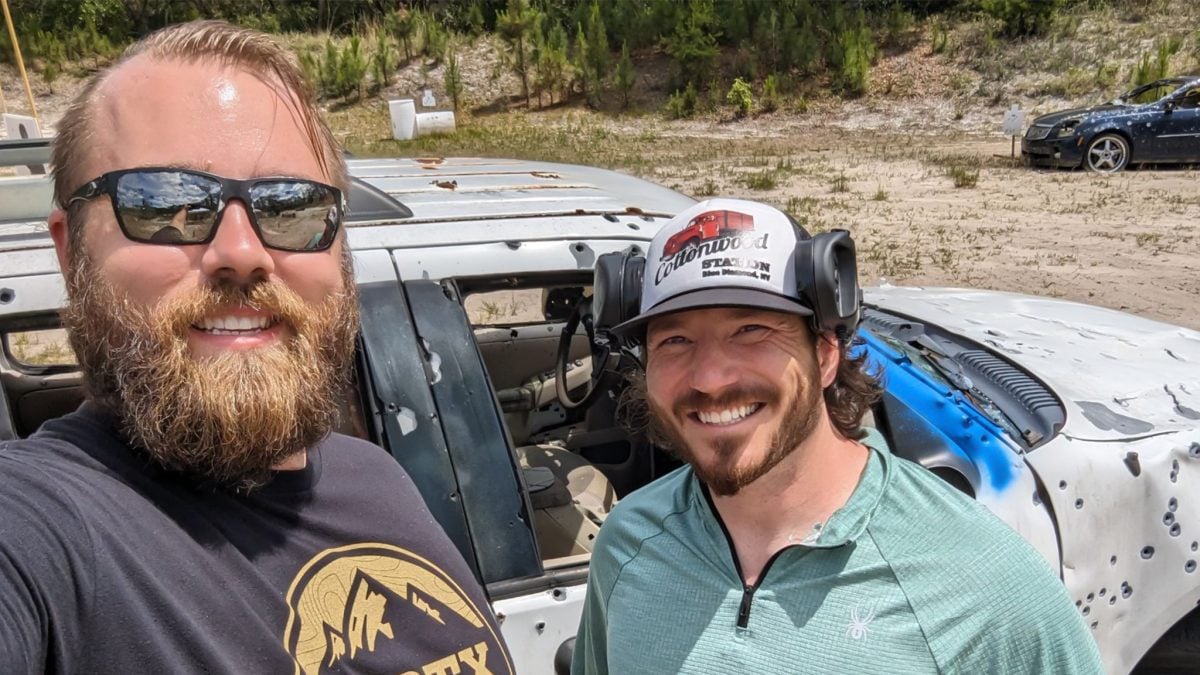
Editing this article is Scott Murdock. Scott is a Marine Corps veteran who competed and qualified as a rifle and pistol expert while in service. In addition to shooting, Scott has written for a variety of publications, testing, researching, and evaluating guns and gear. He brings that knowledge and skillset to this article, editing and fact-checking for accuracy.
Editor-in-Chief Jacki Billings runs our experienced team of reviewers. She is a National Rifle Association Basic Pistol Instructor as well as a member of the Society of Professional Journalists, ACES: Society for Editing, and the Professional Outdoor Media Association. Jacki has a bachelor’s degree in journalism and has worked as a media professional for close to 20 years, specializing in gun media for almost 10 years. With 2,000+ articles to her name, she uses her professional journalism and editing experience to set testing protocols and editorial standards for Pew Pew Tactical.
Final Thoughts
A car-based survival kit’s focus is getting the vehicle back on the road. Because let’s face it, your best chance at survival rests in your ability to travel.
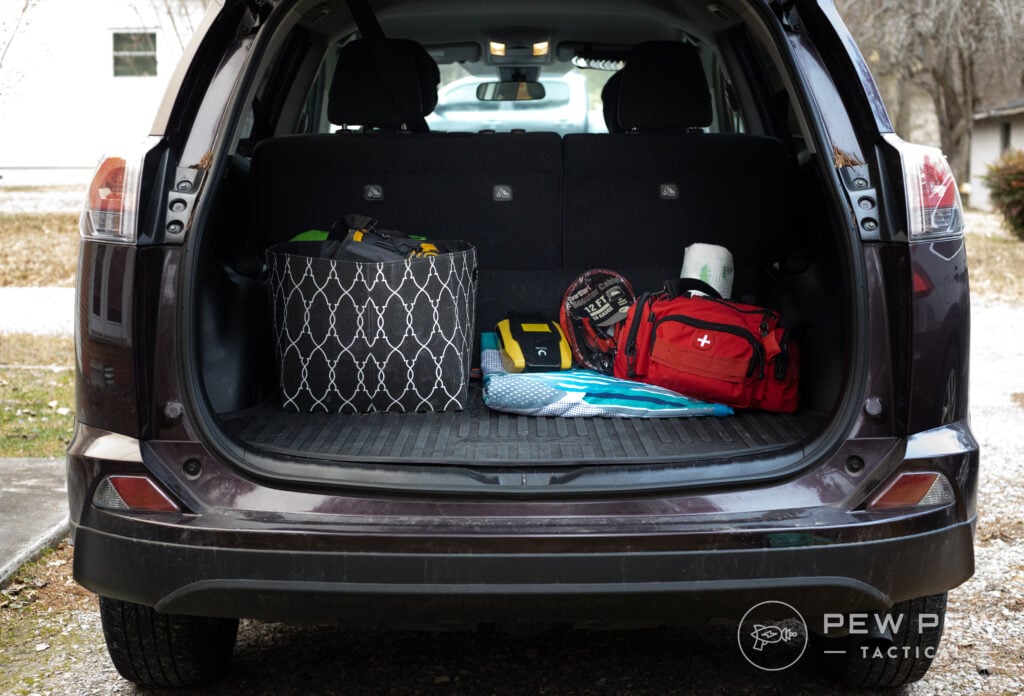
With that in mind, building a survival kit that incorporates the car’s needs and human needs is a great idea.
What are some of your favorite things to keep in your car for survival? Let us know in the comments. Looking for more ways to stay prepared? Check out our Ultimate Bug Out List for all the essentials you need.
Latest Updates
March 2025: Thorough overhaul with new products and supporting content.

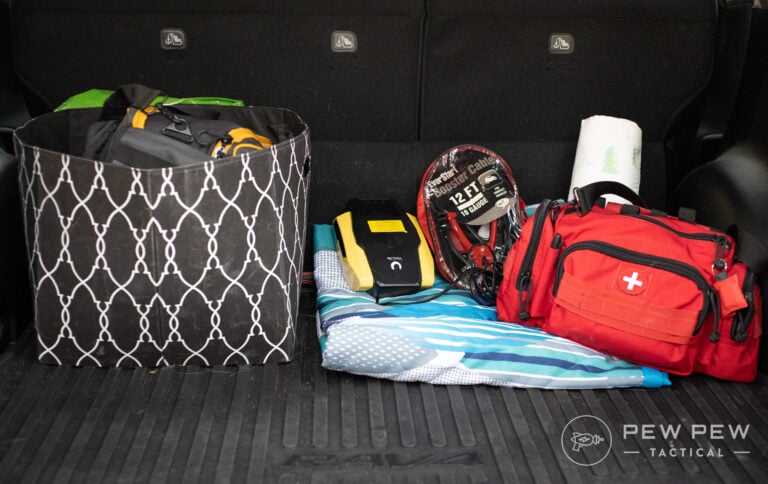




















10 Leave a Reply
Bottle jacks work great on trucks, good luck getting one under my wife's BMW even with fully inflated tires.
Bottle jack is from China.
Ratchet straps or at least bungee cords. Spare fuses. Tools (screwdriver, small socket set, adjustable wrench, needle nose pliers.) HeatMax Survival Heat, hand/foot warmers. Survival blanket/tent. Hat, sunglasses, suntan lotion or beanie, scarf depending on weather.
CASH, small bills.
Why are you constantly sending us to Amazon? How about we bypass Amazon and go direct to the product supplier? Amazon is not worth the convenience and hate people like us anyway.
My thoughts exactly. This is a good opportunity to promote smaller businesses, especially if they're American.
I try to avoid Amazon when I can. But if affiliate links help keep the lights on at PPT and allow us to enjoy free articles, I can deal with that. PPT is still one of my favorite blogs.
Ugh. Now my trunk is full.
A couple things you may want to add to your article.
1) Take the cheapest, crappiest, set of jumper cables. Clean oxidation and solder the wire strands to the actual clamps where they are crimped on. Do this on all four clamps and your cheap jumper cables will ALWAYS work BETTER than an expensive set of cables that was sitting in your trunk, oxidation and resistance building up for a year or two...
2) Fix-A-Flat sounds like a great idea, but if you use it then you need to have your tire taken off the rim and have that liquid glue washed out. otherwise the liquid inside will throw your tire balance off and your balance and alignment will all go to hell... And I don't have to mention that most places will just stuff a rubber plug in your tire without taking it off the rim when you go to get the permanent fix after you use the can of goop...
1) Auto wiring standards are NO SOLDER, as it heats the copper wires making them brittle, causing them to break as they are handled. Properly crimping the wire means getting up to 1000# of pull out strength - and nobody makes the clamp connection do that. An electrical fitting is necessary, plus the tool to properly do it, then attach it to the clamp. For the most part it's not that necessary.
Fix a Flat is a mess, and tire shops charge extra to clean it out when fixing a flat. On the other hand, gelled antifreeze has been used for decades, to BALANCE TIRES on OTR trucks. No it does NOT cause out of balance, and more than the new ceramic beads I've used to balance my truck tires. They dynamically balance a tire while spinning and will adjust to tread wear rebalancing them.
If you do use Fix a Flat, fix the tire with the tarred string inserts, which work to seal the hole. Make sure to cut off all excess outside the tread, they will stick to the pavement and pull out, which is aggravating when you have to go three miles down the road to do it all over again while your wife is tapping her toe on the side of the road. Always trim the excess.
Top Secret? You may want to mention the name of your "Superior Product" so that the readers can take advantage of your "Superior Experience" ....